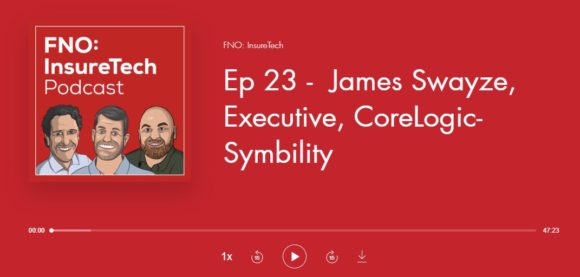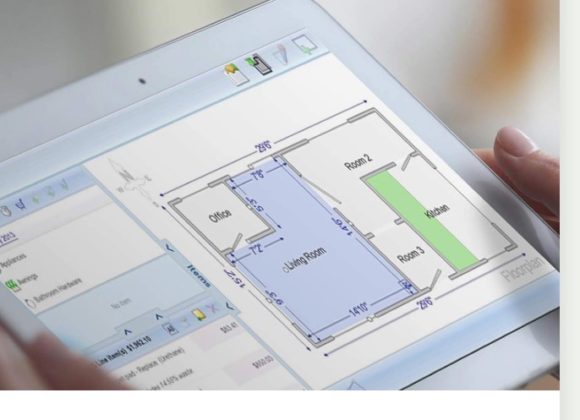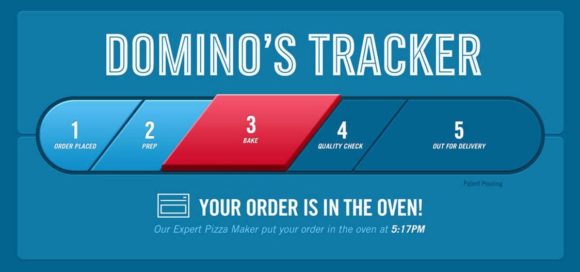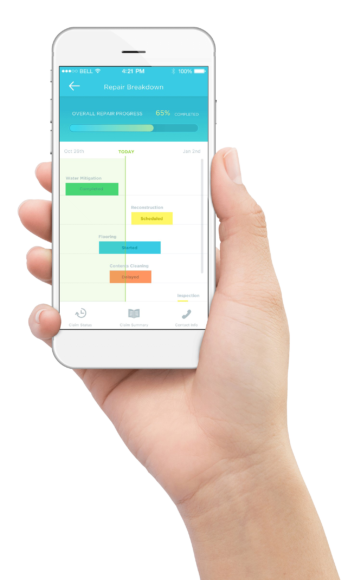This article is part of a sponsored series brought to you by CoreLogic | Symbility. View Series
This post is part of series sponsored by CoreLogic | Symbility.
Oil was once the most valuable resource in the world. Today though, some would say that data is. Data is changing the way business is done everywhere, including the world of insurance. It’s helping us to find new and more efficient ways to operate across almost everything we do. From the analysis of your operations to making sure people know everything about a property before stepping on-site, data has become a powerful tool that any carrier, their employees, and even their customers can and should wield.
“If you can track a pizza on Domino’s—surely you can track where you are on your claim.” -James Swayze, Symbility at CoreLogic
When Symbility Solutions was acquired by CoreLogic just over six months ago, the possibilities as to what can be done with data in the insurance space expanded exponentially. James Swayze, Executive, Symbility at CoreLogic, had this to say about the acquisition: “For us, it’s pretty exciting times right now as we dive deeper into all of the different systems and capabilities and data that we have access to as part of the CoreLogic family and what that means to our existing customers, and what we can offer to future customers and [the] market.”

So, what does it mean for the world of property insurance as the data available to them gets better, easier to access, and more integrated into their operations? James Swayze sat down with the FNO: Insurtech Podcast a few weeks ago to discuss the role data plays in insurance.
Using Data Throughout A Property Lifecycle
Today, there is so much data available coming from such a wide array of sources, there’s no reason that companies shouldn’t be using it to help make better decisions and inform better actions through everything they do. In the property world, businesses will be able to follow all of the data about a property through its entire lifecycle.
Swayze explains how this might play out from the perspective of a home buyer and owner: “Having access to the data that starts at that first moment of looking for a home and carries through the mortgage process, carries through the insurance binding and underwriting process, and come claim time, having it all at the ready. We can then streamline that claim operation when that time comes by virtue of all the data you’ve accumulated all along. And that’s powerful. I think you can speed the process up immeasurably by having access to all that data in advance.”

From the insurance carrier side of the equation, not only will they have data about a property ready for when a claim happens, but property data can also be used to create new business opportunities at the beginning and end of policyholder’s property journey. Because a company like CoreLogic will know when a house goes up for sale, they can share that data with a carrier client who will possibly use it to upsell someone who is going to be needing to review their insurance needs at a new home. Or, at the very least, use that information to retain the customer before they start searching for a new plan somewhere else to go with their new home.
“I think sometimes insurance companies wake up one day and find that their policyholders have left them. They’ve gone somewhere else. They’re not sure why,” Swayze told the FNO: Insurtech hosts. “Well, the reason can often be that they bought a new house and […] had different needs. So giving [their carrier] that heads up that this house is now on the market, [they can say] ‘let’s work together to see how we can help you maintain and expand that relationship.'”
Those are just two examples of how data can help the insurers and the insured, but Swayze says that CoreLogic has loftier goals: “…Our vision is to have an app on everybody’s phone that is effectively like the VIN number for your home with every aspect of when you bought it, and every aspect of the home itself,” he explained.
 Using The Data That Makes The Most Sense
Using The Data That Makes The Most Sense
Until recently, when it came to data that helped to power the property insurance market, many players were willing to work with what was readily available to them. This was the path of least resistance and was seen as “good enough to get the job done.” But over the past two decades or so, technology has advanced and allowed companies to find easier ways of getting extremely accurate data about almost anything they want. This meant that carriers didn’t just have to rely on the data they were able to collect themselves; they could instead purchase better data from those who had it.
Symbility Solutions was not in the business of creating new ways to capture all of that data but instead wanted to help people make sense of the data available. As Swayze puts it, “We knew that we would never be all things to all people, and we wanted to have a platform that enabled the insurance company to choose which other third party systems and companies they wanted to work with. So regardless of which adjusting firms, contracting firms, we certainly could implement our system for all of those companies, but if you wanted other third parties, as I mentioned before, […]then okay. We’ll integrate to that company.”
The open API, a protocol that allows different systems or databases to speak to one another, offered by CoreLogic | Symbility allows them to build connections for any data provider that an insurance carrier could want into their platform. So not only can carriers look to the providers that they feel offer the best data for their business, but by using the Symbility platform they can have that data automatically collected into the same system where they are collecting other data around their claims.
“And what’s better still about that is that there’s a new, cool Insurtech company born every month, and [sometimes it’s] a bunch of kids in their basement building something that can help revolutionize our business,” Swayze continued. “While their tools are cool and companies want to try it, they’re fearful. This is some little startup out of nowhere. What have they done to secure their data? But by integrating them onto our platform, they are now secured within the platform. So one of our insurance company customers can test drive anybody they want, if they ask, [we can say] with confidence, ‘Yeah!'”
Giving Power Back to the Policyholder
Not only is access to data empowering insurance companies to do more, but it’s also giving some power back to the policyholders. For almost the entire history of the property insurance industry, the policyholder was forced to take a backseat and just watch and wait, not having any power to help get their property back to normal. It has always been a frustrating process, but Swayze believes that “if you can track a pizza on Domino’s, surely you can track where you are in your claim.” And CoreLogic | Symbility is already helping policyholders to do this.

Swayze understands that the modern consumer doesn’t want to sit back and cross their fingers that their property will get fixed soon. “[LINK is] an app that allows you as a claimant to follow along with the process of the claim. So you not only have access to all the information around your policy, but you have a direct contact and telephone numbers if need be for the contractor, the adjuster, mitigator, anybody that’s working on the claim. You have a tracking system that shows where you are in the process, what day someone’s coming, and you have the ability to rate whoever [is] walking in your home.”

“LINK […] focuses on the moment of claim and takes all of those sources of data that we’ve been able to integrate to and make them available to the policyholder, and [also] allow[s] the policyholder to take photos and videos, communicate, text, do whatever they need to move the claim along.”
He knows that consumers have options and they’re not afraid to look for a new provider if they think they can get a better deal or service. “The policyholder has expectations today that they never had even a decade ago, and they’re comparing their experience with their bank and their insurance company, but they’re also comparing it with their experience with Amazon and Google and Facebook and everybody else, and the disparity is monstrous.” CoreLogic | Symbility wants to help the insurance industry close that disparity, which is why Swayze adds, “Our view of the future is very much focused around that customer experience and how we can leverage all the toolsets, datasets, and capabilities that CoreLogic has to offer to bring them right to the policyholder themselves and get them engaged in the process.”
If you’d like to hear more about the role that data can play in the property and insurance industries as well as more on where CoreLogic is headed, take a listen to James Swayze’s full interview on the FNO: Insurtech Podcast here.
Authors
 James Swayze holds the title executive, Symbility for Insurance and Spatial Solutions at CoreLogic. In this role, he is responsible for the leading the enterprise-wide strategy and transformation initiatives carried by the global property claims team within CoreLogic.
James Swayze holds the title executive, Symbility for Insurance and Spatial Solutions at CoreLogic. In this role, he is responsible for the leading the enterprise-wide strategy and transformation initiatives carried by the global property claims team within CoreLogic.
James previously served as CEO & founder of Symbility, and has been at the helm of its successful evolution as a global InsurTech provider. He’s an acknowledged expert on the application of technology and how it can modernize the insurance sector, a regular contributor to key industry publications and a sought-after speaker. Prior to founding Symbility, James held various senior executive positions with a number of global technology, financial services and insurance leaders, including General Electric. James was born and raised in Toronto but throughout his career has worked extensively in the United States, France and Germany.
 Sheldon Levine is the Senior Professional, Communications, for CoreLogic | Symbility and Intersect. With a Masters in Public Relations and over 10 years of experience in digital marketing, social media, and content creation, Sheldon is always looking for new and exciting ways to help companies tell their stories through engaging, entertaining, and educational content. Having spent many years in the tech and startup spaces, Sheldon has learned that creativity can be his greatest asset and has used this to elevate B2B companies by changing what people think of as B2B marketing.
Sheldon Levine is the Senior Professional, Communications, for CoreLogic | Symbility and Intersect. With a Masters in Public Relations and over 10 years of experience in digital marketing, social media, and content creation, Sheldon is always looking for new and exciting ways to help companies tell their stories through engaging, entertaining, and educational content. Having spent many years in the tech and startup spaces, Sheldon has learned that creativity can be his greatest asset and has used this to elevate B2B companies by changing what people think of as B2B marketing.

© 2019 CoreLogic, Inc. All rights reserved.
CoreLogic, the CoreLogic logo and CoreLogic | Symbility, LINK, and Video Connect are trademarks of CoreLogic, Inc. and/or its subsidiaries. All other trademarks are properties of their respective holders.
Was this article valuable?
Here are more articles you may enjoy.


 JPMorgan Wins Gender Pay Gap Dispute Against London Analyst
JPMorgan Wins Gender Pay Gap Dispute Against London Analyst  Tata Steel Says NGO Seeking $1.6B for Alleged Health Damage
Tata Steel Says NGO Seeking $1.6B for Alleged Health Damage  Insurance Payments Now at $22.4B From LA Wildfires One Year Ago
Insurance Payments Now at $22.4B From LA Wildfires One Year Ago  Storm Goretti Batters Europe With Violent Winds, Power Cuts
Storm Goretti Batters Europe With Violent Winds, Power Cuts 